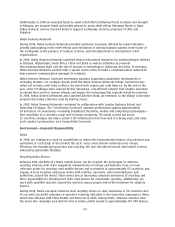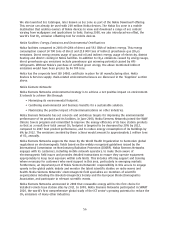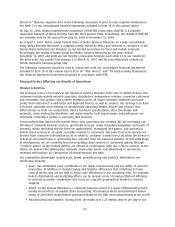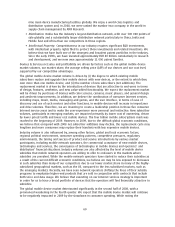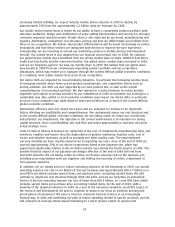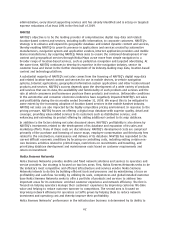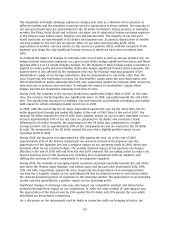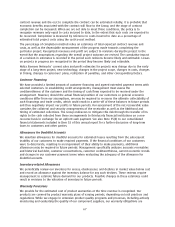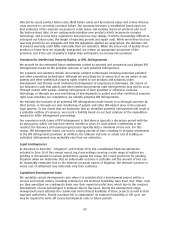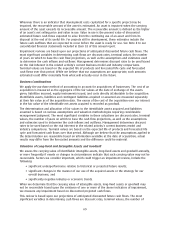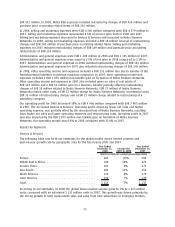Nokia 2008 Annual Report Download - page 64
Download and view the complete annual report
Please find page 64 of the 2008 Nokia annual report below. You can navigate through the pages in the report by either clicking on the pages listed below, or by using the keyword search tool below to find specific information within the annual report.satisfy the competitive and complex requirements of the market and its current and potential
customers. Nokia Siemens Networks will need to continue to leverage and, in some cases, improve its
scale, technology and product portfolio to maintain or improve its position in the market.
Nokia Siemens Networks’ net sales depend on various developments in the mobile and fixed
infrastructure market, such as network operator investments, the pricing environment, and product
mix. In developed markets, operator investments are primarily driven by capacity upgrades—which
are driven by greater usage of the networks—both for voice calls and increasingly for data usage.
Also, in developed markets, the investments of the network operators are driven by evolution of
network technologies and an increasing need for efficiency. In the emerging markets, the principal
factors influencing the operator investments are the growth in network coverage and the growth in
the number of subscribers. Nokia Siemens Networks’ net sales are also impacted by pricing
developments. The products and solutions offered by Nokia Siemens Networks business are subject to
price erosion over time, largely as a result of technology maturation and competitive forces in the
market. Further, Nokia Siemens Networks’ net sales are affected by the product mix—the mix of
hardware sales, software sales and services sales. Net sales are also impacted by regional mix—the
balance between sales in developed and emerging markets.
We estimate that the mobile infrastructure, fixed infrastructure and related services market will
decline 5% or more in euro terms in 2009, from 2008 levels. The decline is expected to result
primarily from the overall slowdown in the investments of network operators and service providers in
the current difficult global economic conditions. We target for Nokia Siemens Networks market share
to remain constant in 2009, compared to 2008. Nokia Siemens Networks market share may be
adversely impacted by its focus on profitability and cash flow and deal discipline. However, we
believe this impact may be offset as its market share should benefit from a favorable technology mix
in its products and services portfolio.
There are several factors that drive the profitability at Nokia Siemens Networks. First, there are the
drivers of net sales discussed above. In addition, the scale, operational efficiency and cost control
have been and will continue to be important factors affecting Nokia Siemens Networks’ profitability
and competitiveness. Nokia Siemens Networks’ product costs are comprised of the cost of
components, manufacturing, labor and overhead, royalties and license fees, the depreciation of
product machinery, logistics costs as well as warranty and other quality costs. Nokia Siemens
Networks’ profitability is also impacted by the pricing environment, product mix and regional mix.
The pricing environment in the markets where Nokia Siemens Networks operates continued to be
intense in 2008, and we expect that these general market conditions will continue in 2009. Nokia
Siemens Networks delivered on its commitment to achieve substantially all of the EUR 2 billion of
targeted annual cost synergies by the end of 2008. In November 2008, Nokia Siemens Networks
announced that it had completed the preliminary planning process to identify the proposed
remaining headcount reductions necessary to reach its previously announced synergyrelated
headcount adjustment goal of 9 000 employees and began the process of sharing those plans with
employees and their representatives. In order to maintain a competitive cost structure and to achieve
further cost reductions, Nokia Siemens Networks will continue to focus on leveraging its cost
advantages, which will include strict deal discipline, real estate and factory consolidation, supply
chain optimization, global resource balancing and continued IT and process development.
Certain Other Factors
Exchange Rates
Our business and results of operations are from time to time affected by changes in exchange rates,
particularly between the euro, our reporting currency, and other currencies such as the US dollar, the
Japanese yen, the Chinese yuan and the UK pound sterling. See Item 3.A “Selected Financial Data—
Exchange Rate Data.” Foreign currency denominated assets and liabilities, together with highly
probable purchase and sale commitments, give rise to foreign exchange exposure.
63



